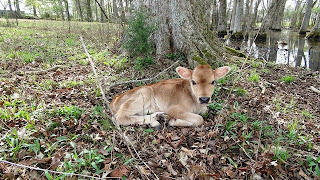I still don't understand everything behind MIG, it seems like there's a lifetimes worth of knowledge to learn about it, but the basics of it just make good sense. The oposite to MIG is continouous grazing. The two systems work like this:
Continuous Grazing - This is what is generally practiced by just about all cattle farmers that you will see because it's the easiest. You just turn the cows into a pasture and let them graze. The downside to continuous grazing (just letting them roam free) is that the cow can pick and choose what they want to eat. The result of this is that they don't eat the weeds at all and generally skip over all of the more mature forage and just eat all of the young tender grasses. This will eventually leave "holes" in the grass where the cow keeps the grass eaten down while allowing the weeds and other not so palatable grasses to grow uncontrolled. Here is a picture of what I call a "hole" in your forage where the cow keeps the forage eaten down so she can just have the tender forage while the grass around it grows up.
Also, the cows will have their favorite places to shade, lay down, and go when it rains which will lead to those areas being impacted much higher than anywhere else and usually turning to dirt with no forage at all.
The alternative is:
Management Intensive Grazing - M.I.G. is where you split your pasture into small sections and keep the cows together in very tight areas moving them often to fresh grass, preferably moving them every day. There are many benefits to M.I.G. that I have read about and seen work myself:
1) Instead of the cows being able to pick and chose what they eat they will have to eat everything in their small pasture and the forage will be harvested much more evenly. This in turn will discourage the growth of weeds and encourage the growth of good grasses and legumes.
2) The stock should get better nutrition as they are getting a much better variety of forage.
3) Ideally, the cows will be confined close enough so that they trample down about 40-50% of the grass so that when they are moved the forage that was trampled will mulch into the soil greatly enriching it and in turn causing it to be of better quality as well.
4) The manure of the cows will be much more concentrated and evenly spread. I think this is one of the greatest benefits as it fertilizes your grass wonderfully and reduces one of most farmer's greatest costs; fertilizer.
5) The pasture that does not have cows on it will have a chance to grow to maturity and grow to a seed head which will give you more and thicker forage as well as you will have more seeds hitting the ground.
There are a great many more things that are beneficial about MIG and many great books written on the subject. Everything I have read however, is always in reference to a "herd" of cattle. Well, I'm just starting out and don't have a herd of cattle or even room to have more than 2-3 cattle. So can it still work for me with just one cow & a calf?
I decided I would give it a try and have been experimenting with MIG for about 3 weeks now. I bought a 10 mile solar powered electric fence charger,
1/2 mile of electric fencing wire, and about 20 electric fence poles. I have been making large rectangles with metal t-posts at the corners about 20'x300'. I run a wire across the width of the rectangle which confines the cow and I move the wire every day so she has access to new grass. As I am working with a milk cow I have to keep the calf away so I just put him on the other side of the wire that keeps her in a tight space. There is no need to put a wire across the back behind where the cow has eaten as the cow isn't interested in eating what she has already eaten down. I move the entire rectangle about once every 7-10 days as it takes the cow about that long to work her way through.
 |
| Here you can see the rectangle, and the pole in the middle of the rectangle behind the cow is where the wire that keeps her from getting to the new grass is. |
Here are some photos of how it has been working:
 |
| Here you can see the difference of where the cow has eaten down the forage on the right, while on the left the forage has been left to grow. |
 |
| Here you can see all the manure that was left behind after just one week. Black gold! |
 |
| The forage that has not been harvested and left to grow has really taken off in other sections of the pasture. |
 |
| Here is a section where the cow has not been on at all and it has been growing up for about 2 weeks. |
All in all, I am enjoying M.I.G. so far and I think it will be very good for our land. I am hoping it will cut down on hay consumption this winter and will let you know how that goes. If you are already using M.I.G. let me know how it has worked for you. If anyone has any advice on this system I would love to hear it!
As a side note, we also got a new puppy recently. Marshall loves him and he has affectionately named him "Buppy". I think the name will stick.
 |
| "Buppy". Our little Golden Retriever puppy. |
Happy stewarding!
-The Farmer



























